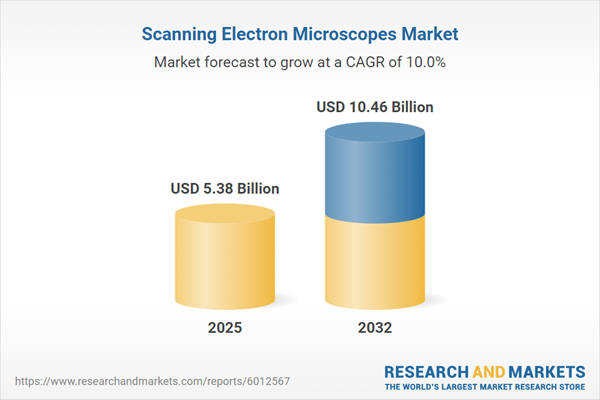Speak directly to the analyst to clarify any post sales queries you may have.
The scanning electron microscopes market is evolving rapidly, empowering advanced imaging and analysis for research and industry. As technology adoption accelerates, sector leaders are re-evaluating workflows, supply chains, and strategic positioning to stay ahead.
Market Snapshot: Scanning Electron Microscopes Market Overview
The global scanning electron microscopes market has demonstrated resilient growth, rising from USD 4.89 billion in 2024 to USD 5.38 billion in 2025. Projected to expand at a compound annual growth rate (CAGR) of 9.95%, the market is forecast to reach USD 10.46 billion by 2032. This progress is driven by the convergence of emerging applications across advanced materials research, nanotechnology, life sciences, and industrial quality control.
Scope & Segmentation of the Scanning Electron Microscopes Market
Comprehensive analysis reveals distinct growth avenues determined by technology choices, usage environments, and regional dynamics. This report examines:
- Product Type: Conventional SEMs, Environmental SEMs, Field Emission SEMs
- Electron Source: Field Emission Gun (including Cold Field Emission and Schottky Emitter), Lanthanum Hexaboride, Tungsten Filament
- Application: Biological Imaging, Failure Analysis, Material Characterization, Nanotechnology Research, Semiconductor Inspection
- End User: Academia, Automotive, Electronics, Healthcare
- Sales Channel: Direct Sales, Distributors, Online
- Regional Coverage: Americas (including North America, Latin America), Europe, Middle East & Africa, Asia-Pacific
- Key Companies Profiled: Thermo Fisher Scientific Inc., JEOL Ltd., Hitachi High-Tech Corporation, Carl Zeiss AG, Bruker Corporation, Keyence Corporation, TESCAN Group a.s., ULVAC Inc., COXEM Co., Ltd., SII NanoTechnology Inc. by Seiko Instruments Inc.
Key Takeaways for Senior Decision-Makers
- Modern scanning electron microscopes (SEMs) have evolved from specialized laboratory tools into pivotal resources for high-throughput analysis and innovation across academic, industrial, and medical fields.
- Recent advances in electron optics, detector performance, and environmental controls broaden applications, including in-situ biological imaging and complex materials evaluation.
- Automation and integration of artificial intelligence enable unattended sample workflows, streamlined defect analysis, and faster interpretation of experimental outcomes at scale.
- Partnerships between technology providers, manufacturers, and research centers are shaping agile innovation pipelines and fostering flexible responses to global market shifts.
- Expanding end-user segments such as electronics manufacturing and healthcare are leveraging SEM solutions to address critical needs in device reliability and advanced material testing.
- Direct sales remain dominant for high-value systems, though distributor and online channels are playing larger roles in supporting procurement agility and market access.
Tariff Impact: Navigating Trade Policy Changes
Adjustments to international tariffs in 2025 have introduced cost complexities for SEM component sourcing and global distribution. Manufacturers are diversifying supplier bases and shifting some production operations closer to target markets. Strategic collaborations and local alliances help mitigate supply disruptions and offer new value-added services to offset increased landed costs for end users.
Methodology & Data Sources
This report applies a dual-stage research methodology, combining executive interviews and insights from market practitioners with thorough reviews of patent filings, technical literature, and company disclosures. All quantitative findings are validated through cross-checking with proprietary databases and expert reviews, ensuring a robust foundation for investment and operational decisions.
Why This Report Matters for Stakeholders
- Enables executive teams to identify actionable opportunities in product positioning, regional expansion, and channel strategy within the scanning electron microscope market.
- Arms R&D and procurement leaders with granular insights on emerging technical advancements and best practices for supply chain risk management.
Conclusion
The scanning electron microscopes market continues to develop new capabilities and applications, shaped by technology, policy, and end-user priorities. Strategic investments in advanced analytics, partnerships, and flexible supply chains will be key for market leadership amid ongoing industry transformation.
Additional Product Information:
- Purchase of this report includes 1 year online access with quarterly updates.
- This report can be updated on request. Please contact our Customer Experience team using the Ask a Question widget on our website.
Table of Contents
3. Executive Summary
4. Market Overview
7. Cumulative Impact of Artificial Intelligence 2025
Companies Mentioned
The companies profiled in this Scanning Electron Microscopes market report include:- Thermo Fisher Scientific Inc.
- JEOL Ltd.
- Hitachi High-Tech Corporation
- Carl Zeiss AG
- Bruker Corporation
- Keyence Corporation
- TESCAN Group a.s.
- ULVAC, Inc.
- COXEM Co., Ltd.
- SII NanoTechnology Inc. by Seiko Instruments Inc.
Table Information
| Report Attribute | Details |
|---|---|
| No. of Pages | 187 |
| Published | October 2025 |
| Forecast Period | 2025 - 2032 |
| Estimated Market Value ( USD | $ 5.38 Billion |
| Forecasted Market Value ( USD | $ 10.46 Billion |
| Compound Annual Growth Rate | 9.9% |
| Regions Covered | Global |
| No. of Companies Mentioned | 11 |









